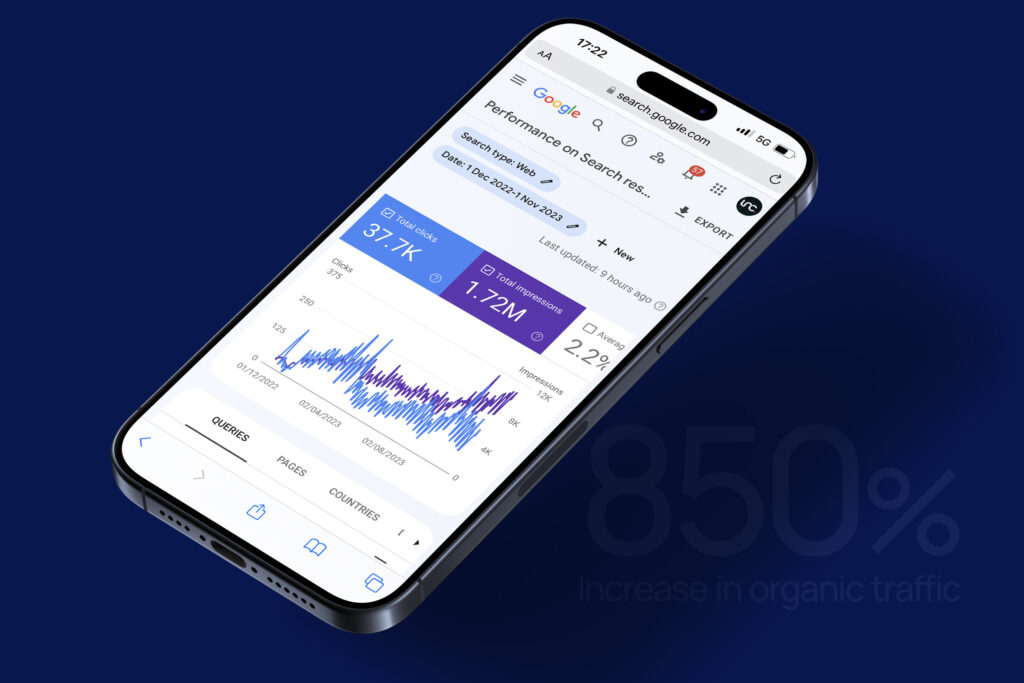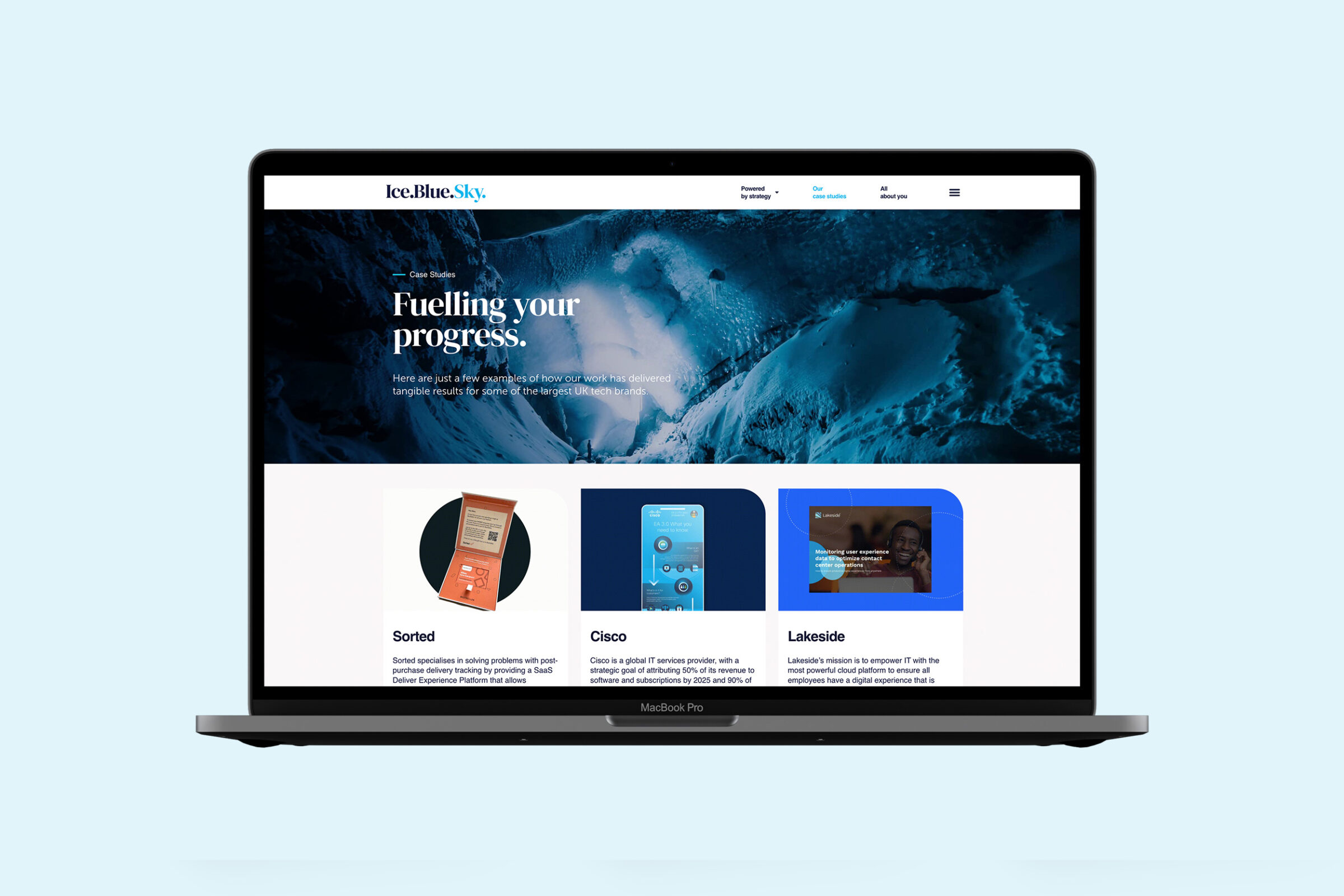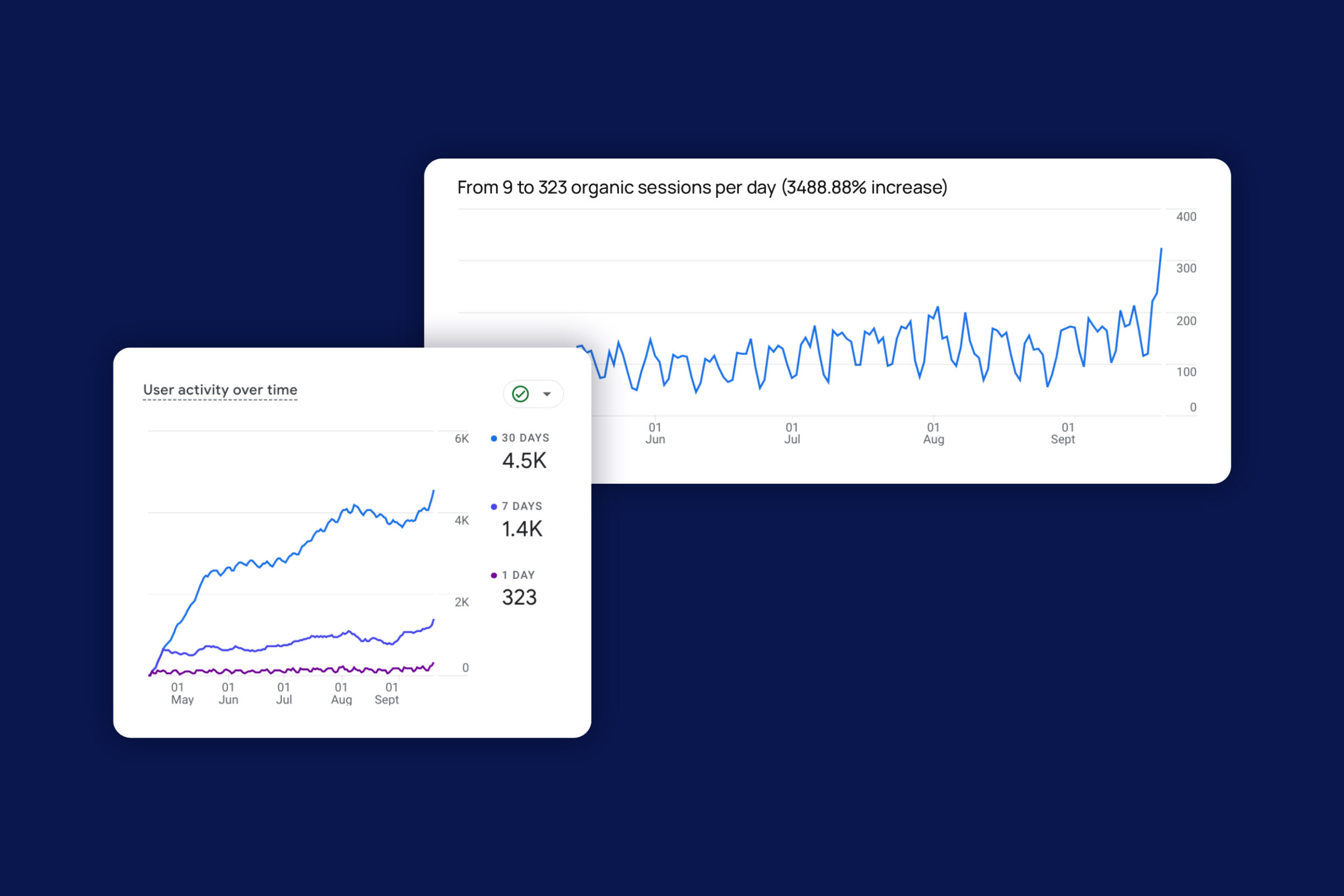How to Get to the Top of a Google Search
It’s a tale as old as time (as long as you only go back to the 1990’s). You’ve made a fantastic website, you’ve published it expecting big results, and… nothing.
With more than 202 million active websites on the internet, it’s no longer enough to simply put your site out there and hope for the best. You need to take an active role in making sure your website is visible and noticed by the right people.
But what does it mean to get your website noticed?
While the definition and metrics can change depending on who you ask, at its core, getting your website noticed in B2B and B2C spaces means increasing its online visibility, brand awareness and user engagement.
This goes far beyond a singular search engine optimisation strategy.
Being an experienced creative agency, we used our experience to optimise one of our client’s websites and managed to increase their organic traffic by 850% in just six months. Yes, you read that right. search engine optimization
But before we get into that, let us first outline what each of these three key aspects involves.
Online Visibility
On a fundamental level, website visibility refers to how easily your page can be found on search engines like Google.
This is much more than bragging rights. It’s about securing a prime spot on that first page, which is essentially the digital version of a bustling high street.
The more visible your website, the more organic traffic it’s likely to attract, which, in turn, can lead to conversions and sales.
Brand Awareness
Building brand awareness is about making sure that your target audience knows who you are, what you do and why they should choose you over the competition.
This can be achieved through various marketing strategies, including social media campaigns, influencer marketing, content marketing, and targeted search engine optimisation strategy.
The more people know about your brand and associate it with quality and value, the higher the chances of them choosing your company for their needs.
User Engagement
A website with high user engagement is one where users are actively interacting with the site through clicks, comments, shares and time spent on the page. This indicates that your content and website design are engaging, relevant and valuable to your target audience.
User engagement not only helps improve your website’s ranking on search engines but also has a direct impact on customer loyalty and conversions.
Now that we’ve covered the three pillars of getting your website noticed, let’s dive into how we achieved a whopping 850% increase in organic traffic for our client.

Table of Contents
Case Study: How We Generated an 850%+ Increase in Organic Traffic
One of our clients reached out to Inc Studio in October 2022 looking for an updated website that would get their business noticed and create more leads.
It was clear to us that we would need to create a strategy that would build up website visibility, brand awareness and user engagement.
After conducting thorough market research and competitor analysis, we identified a range of factors holding our clients back that we quickly addressed, including:
Unoptimised content
A slow website speed
Poor mobile optimisation
Lack of quality content and regular updates
Within the space of six months, our tailored strategy had created an 850% increase in organic traffic, with our clients experiencing a 700% increase in organic leads.
More than a year later, our strategy has reached over 2 million individual users and generated over 45,500 clicks.
But how did we do it?
In this blog post, we will outline the key elements of our strategy, from SEO strategy to content creation and design optimisation. We hope that by sharing our experience, we can help you improve your website’s visibility and attract more organic traffic.
Keep reading to learn more.
How Did This Happen?
If you’re looking to get your website noticed you need to take a holistic approach.
Placing a single focus on SEO or Google ads will ultimately result in missed opportunities and a lack of sustainable growth.
This rings especially when other key aspects are ignored, such as website performance, user experience, and quality content creation.
Simply put, without a strong foundation to build upon, your marketing efforts will not have the desired impact.
In the case of So Eco, we used an all-encompassing strategy that addressed the three pillars mentioned earlier: online visibility, brand awareness and user engagement.
As with any growth strategy, each aspect is arguably as important as the other. This helped our team create a solid and sustainable approach to drive organic traffic and conversions.
KPIs to Measure Website Growth
Key Performance Indicators (KPIs) are crucial metrics that help measure the success of your website in terms of online visibility, brand awareness, and user engagement.
Before embarking on a strategy of growth, you must first set SMART goals that can be used to set realistic expectations and achieve tangible results.
So, what are some of the key KPIs to pay attention to when it comes to measuring website growth?
KPIs for Online Visibility
Organic Search Traffic: The number of visitors that come to your website from a search engine’s organic results.
Search Engine Rankings: Positions of your website’s pages on search engine results pages (SERPs) for relevant keywords.
Click-Through Rate (CTR): The percentage of searchers who click on your website after seeing it in the search results.
Domain Authority: A score that predicts how well a website will rank on search engine result pages.
KPIs for Brand Awareness
Direct Traffic: The number of visitors that come to your website by typing your URL directly into their browser, which indicates brand recall.
Social Shares and Mentions: How often your brand or content is shared or discussed on social media platforms.
Brand Search Volume: The frequency at which people are searching for your brand name on search engines.
Media Coverage: The quantity and quality of media mentions across the web and offline media.
KPIs for User Engagement
Bounce Rate: The percentage of visitors who navigate away from the site after viewing only one page, indicating the relevance and engagement of the content.
Average Session Duration: The average length of a session on your website, offering insights into user engagement levels.
Pages per Session: The average number of pages a user visits during a session, which can reflect the level of interest and engagement with your content.
Conversion Rate: The percentage of visitors who take a desired action on the site, like filling in a contact form or making a purchase.
By carefully monitoring these KPIs, we can assess the effectiveness of our strategies and make informed decisions on where to optimise for even better results.
How to Get Your Website Noticed: Step-by-Step Guide
Setting off on your journey to digital prominence requires a clear roadmap—think of it as your personal guide through the ever-shifting landscape of the internet.
With each step being as important as the last to elevate your online presence and captivate your target audience, we’ll discuss all the key elements that go into creating a successful strategy for your website.
1. Acquiring Your Website Domain and Hosting
So, you’re eager to mark your spot on the internet and ready to get your website out there. Let’s start from square one, shall we?
Your domain name is essentially your online street address – it has to be spot-on.
You might already have your website domain sorted, but in case you don’t, here’s how you can acquire one:
Choose a registrar: This is where you buy your domain name from. Popular registrars include GoDaddy, Namecheap, and Google Domains.
Search for availability: Type in the desired domain name to see if it’s available.
Add to cart and purchase: If the domain is available, add it to your cart and purchase it.
Next up is choosing a home for your website – that’s where web hosting comes into play. Think of it as choosing the best high-street spot for your shop; you need it to be reliable and quick.
Why so?
Because a sluggish website can be a real turn-off for visitors, and you wouldn’t want that derailing your journey to online success.
When you choose a secure hosting service, you’re laying down a sturdy foundation. It’s like making sure the lights always stay on and the open sign is brightly lit for your digital visitors.
It’s step one to ensure your website stands out from the crowd and gets the attention it truly deserves.
2. Crafting a User-Friendly Website That Works Everywhere
Picture this: a customer visits your website on their mobile during a coffee break—and everything just works. It’s slick, it’s quick, and it looks great.
That’s what a responsive website does – it makes sure your digital presence is top-notch on any device, be it a smartphone, tablet, or desktop.
Why does this matter?
Because search engines, like our friend Google, actually reward websites optimised for mobile users with better rankings.
And with nearly 60% of all online searches coming from mobile, this only makes sense!
So if you’re new to this whole digital marketing game, make your website’s responsiveness a top priority with any website update – and watch as it charms both your customers and search engines alike.
3. Submitting Your Sitemap
Submitting your sitemap to search engines is like sending out a personalised invitation to Google or Bing, asking them to swing by and check out your site. Imagine it as giving them a guided tour of your website’s layout.
This step is super helpful because it means search engines can quickly understand and index your pages, making sure your site shows up on Google search results pages effectively.
It’s an essential move for your digital strategy, especially if you’re just dipping your toes into the big ocean of digital marketing.
Regularly updating your sitemap also ensures that the search engines keep up with the latest additions to your online empire.
4. Optimise for Technical SEO
Technical SEO is often overlooked, especially by businesses trying their hand at SEO or digital marketing.
Website speed, crawlability (how easily search engines can explore and index your site), and indexability, are all key parts of technical SEO that contribute to how search engines perceive your site.
Simply put, poor technical SEO results in poor performance on SERPs.
Here are some key aspects to consider when optimising for technical SEO:
Page Loading Speed: If a page takes more than three seconds to load, more than 50% of users will abandon your page and go elsewhere, leading to a higher bounce rate. Optimising images, minifying code, and reducing server response time are all ways to improve page speed. Use specialist tools, such as Google’s PageSpeed Insights to learn how fast your website loads.
Mobile-Friendliness: As mentioned earlier, a mobile-friendly site is crucial for both user experience and SEO. Use Google’s Mobile-Friendly Test tool to see if your site meets the criteria.
Broken Links: Broken links can negatively affect your website’s crawlability and user experience. Regularly checking for broken links and fixing them can help improve your site’s overall health.
Navigation: A clear and user-friendly navigation structure is important for both user experience and search engines. Make sure your website’s navigation is intuitive and easy to follow.

5. Prioritise User Experience
Not only is user experience (UX) a key ranking factor for a Google site search, but it also plays a crucial role in converting visitors into customers.
The truth is in 2024, content is no longer king. Many have argued that user experience has taken the crown.
After all, it’s UX that keeps users engaged and on your site for longer.
While high-quality content is important, ultimately, it is the user who will determine the success of your website.
Digital marketers can use tools, such as Google Search Console and Google Analytics, to monitor the proigres of pages and ertermine which
Some key elements to consider when optimising for UX/UI design include:
Simplicity in Design: Aim for a layout that’s easy on the eyes; avoid clutter and focus on delivering a straightforward message.
Intuitive Navigation: Make it as easy as possible for visitors to find their way around your site; a good sign is if they can get where they want to be in just a few clicks.
Fast Loading Times: Ensure your pages load swiftly to keep your audience from turning away in frustration.
Engaging Content: Keep content relevant and updated to persuade visitors to come back time and time again.
6. Find Valuable Keywords (Including Long-Tail)
When you think of SEO, keywords are most likely the first thing that comes to mind. Finding the right keywords and incorporating them into your content is crucial for driving organic traffic to your site and increasing your online visibility.
However, in competitive fields, it can be challenging to rank for popular keywords – even if you’re an industry leader with a high domain authority.
That’s where long-tail keywords come in.
Long-tail keywords are specific and often longer search phrases that have less competition within your niche.
By targeting these types of keywords in your content, you have a better chance of ranking higher and driving more targeted traffic to your site.
When researching keywords, you must consider:
Search volume: How often is the keyword searched for?
Competition: How many other websites are also targeting this keyword and how hard would it be to rank given the current condition of your website?
Relevance: Is the keyword relevant to your content and target audience?
Pro Keyword Tip:
Don’t be afraid to use a mix of short and long-tail keywords in your content. This can help diversify your strategy and improve your chances of ranking for multiple terms.
7. Understand the Target Audience and Search Intent
Following on from the previous point, in every piece of content you create, you should have a detailed understanding of exactly who your target audience is and what they’re looking for.
To do this, there are two steps you need to consider.
The first is the buyer persona.
A buyer persona is a detailed profile of your target customer, including their demographics, interests, and pain points. Understanding this allows you to tailor your content specifically to them.
The second is search intent.
Search intent refers to the reason behind a user’s search query. Understanding what people are looking for when they use specific keywords can help you create more targeted and relevant content when advertising. to them.
For example, if a user searches for “best running shoes,” their intent could be to buy a new pair, read reviews, or find out more information about different brands. Knowing this can help you create content that satisfies the user’s intent and increases your chances of ranking higher.
By understanding your target audience and their search intent, you can ensure that each piece of content on your website is valuable and meets their specific needs – ultimately increasing the chances of converting them into loyal customers.
8. Create High-Quality Content
As we mentioned, for years content has been king. And while other ranking factors, such as user experience, have diluted the singular importance of high-quality content, that’s not to say it’s any less valuable.
In fact, creating high-quality, informative and evergreen content is still one of the best ways to improve your website’s visibility on search engines and attract organic traffic.
When creating content for your site or business blog, make sure to remember:
Keywords: Use relevant keywords throughout the content (but don’t keyword stuff, as this can result in serious penalties!)
Value: Offer something new and of value to the reader in each piece of content.
Readability: Keep sentences and paragraphs short and easy to read.
Structure: Use headings, bullet points and images to break up large blocks of text.
Links: Link to reputable sources and include internal links within your site.
Intent: Match the search intent of your target keyword.
Resonate: Understand your target audience and create content that resonates with them.
9. Compelling Page Titles and Metadata
Now you’ve created great content that’s optimised for a specific keyword, the next step is to inspire a user to visit your page when they see it listed on a SERP. The first thing they will see is your page title and meta description.
Both your page title and meta description should include relevant keywords, but also be compelling enough to entice the user to click through to your site.
Although Google rewrites more than 60% of meta descriptions, it’s still important to include them and optimise them for maximum click-through rate (CTR).
By grabbing the user’s attention and encouraging them to click through, you’ll improve the chances of your page ranking higher on search engines.
Keep these tips in mind when creating titles and metadata:
Make sure both accurately describe the content on the page engagingly and uniquely.
Include numbers and statistics where applicable (e.g. “10 ways to improve your SEO”).
Use action-oriented language (e.g. “Discover”, “Learn”, “Find out”).
Pro Metadata Tip:
A/B testing your page titles and meta descriptions can help you determine which ones are most effective for driving traffic to your site. Be sure to review and update them regularly as well.
10. Structure Pages
When crawling through a website’s pages, a search engine’s bot will read them in a specific order. This means that the structure of your page is essential for SEO.
A well-structured page can help search engines understand and index your content better, increasing the chances of ranking higher.
When structuring pages on your site, make sure to:
Use headings (H1, H2 etc.) to break up and organise content into sections.
Include relevant keywords in headings and subheadings.
Use descriptive anchor text for internal links.
Keep paragraphs short and concise.
Use bullet points and numbered lists where applicable.
By following these tips, you can improve the readability of your content and make it easier for both users and search engines to understand its context. This will help increase the chances of ranking higher for your target keywords.
11. Optimised Images
Content optimisation isn’t the only effective way to maximise the potential of your website pages.
Images are an effective tool for engaging users and breaking up large blocks of text. But they also present an opportunity for SEO.
When adding images to your website, make sure to:
Use high-quality images that are relevant to the content on the page.
Compress them to improve site speed and user experience.
Include descriptive file names and alt text with relevant keywords.
Use responsive design for mobile-friendliness.
By optimising your images, you can improve the overall quality and user experience of your site while also giving search engines more information about the content on each page. This can contribute to better rankings and increased organic traffic.
12. Build a Memorable Brand
Throughout the process of upgrading your online presence, you should also consider updating your existing brand to match the new look and feel of your website.
Your brand is not just about a logo, colour scheme or catchy tagline; it’s the story you tell and the impression you make on potential customers.
An authentic and memorable brand leaves a lasting impression on customers, making them more likely to return for repeat business and refer others to your site.
Some ways to build a memorable brand include:
Consistent Brand Voice: Establishing a consistent tone and voice in all of your content can help customers connect with your brand.
Visual Branding: Consistent visual elements like colour schemes, fonts, and imagery can help create a recognisable brand identity.
Storytelling: Share the story behind your brand and products/services to create an emotional connection with customers.
13. Register for Directories
Off-page SEO is the third (and most often overlooked) aspect of search engine optimisation.
This pillar of SEO involves building backlinks to your site from other reputable websites, which signals to search engines that your content is valuable and worth ranking.
A backlink is essentially an endorsement from another website, and registering for online directories is a great way to get those endorsements.
One way to get started with off-page SEO is by registering for online directories. This includes local listings, business directories, and review sites.
Try looking for some free directory listings related to your niche, which will help to improve your online visibility and get your website noticed.
14. Optimise for Local SEO
Tapping into local SEO is like setting up a virtual signpost in your neighbourhood. It helps locals easily find your website when they’re in the market for what you’re peddling.
By optimising your site for local searches, you might just snag a spot in Google’s coveted Local Pack, rake in top-notch customer reviews, and see a spike in website traffic.
It’s all about getting seen where your future customers are already looking.
Through a strategic local SEO campaign, you can:
Get noticed by users actively searching for your type of business.
Appear in Google’s Local Pack (the top results that appear on a map alongside search engine results).
Build up customer reviews and ratings to establish credibility.
Drive more traffic to your website.
15. Consider Incorporating Video
Including videos can not only improve user engagement but also boost your search engine rankings if done correctly.
An effective video can significantly increase engagement metrics, such as time spent on the page and click-through rates.
However, when introducing a video feature to a service page or blog post, you should consider the user’s experience. Videos that auto-play when a user visits the page can be annoying and cause them to bounce, which can negatively impact your SEO.
Moreover, a video can disrupt the look and feel of a page, making it appear cluttered and messy. To avoid these issues, consider incorporating video in a way that enhances the user’s experience.
When embedding a video on one of your web pages, be sure to use this checklist:
Relevance: Make sure the video is relevant to the content on the page.
Quality: Use high-quality videos that are visually appealing and well-produced.
Length: Keep videos to a reasonable length, as users are more likely to watch shorter videos.
Placement: Consider where and how the video fits into the overall design of your page.
Transcripts: Include a transcript of the video on the page for accessibility and to provide search engines with additional context.
16. URL Structure
The way a URL is structured can have a significant impact on how well your website performs on SERPs.
A well-structured URL can help search engines understand the hierarchy of your website and the content on each page.
When creating URLs for your web pages, you should follow these best practices:
Keep it simple: Use clear and concise URLs that accurately reflect the content of each page.
Include keywords: Try to include relevant keywords in your URL, but avoid keyword stuffing.
Avoid using dates: Including dates in URLs can make them appear outdated and may discourage users from clicking on them.
Be consistent: Keep your URL structure consistent throughout your website to maintain a clear hierarchy for search engines to follow.
17. Get Verified on Google My Business
Verifying your business on Google My Business (GMB) is a critical step in amplifying your online presence and ensuring your website garners attention.
By verifying and optimising your GMB listing, your business gains legitimacy and trust from Google, which can improve your local search rankings. As a result, your website becomes more visible to potential customers who are searching for your services or products.
Moreover, a verified Google Business listing provides a platform to showcase essential information like your operating hours, contact details, and customer reviews, which can influence searchers to engage directly with your business.
That’s not to mention other search engines have their equivalent platform, such as Bing Places.
Essentially, Google My Business acts as a powerful tool for enhancing your digital storefront and driving more traffic to your website.
18. Promote Content on Social Media
With more than 4.26 billion people using social media globally, engaging with social media might just be the secret ingredient to expanding your brand’s online footprint.
Think of it as your digital megaphone, giving you a way to shout out about your awesome content to the world.
The key idea of social media marketing is to share your best bits—blog posts, tutorials, promotions—across networks like Facebook, Twitter (or X), Instagram, and LinkedIn where people hang out and talk about, well, pretty much everything.
But to be truly effective you need to find the spaces where your potential clients are already engaging, such as under relevant hashtags or in specific groups. After all, you want your content to get noticed by those who are most likely to engage with it.
Imagine you’re at a networking event but in the digital realm, mingling with potential customers and like-minded folks. As you get chatty, sharing tidbits and helpful info, people get to know and trust your brand.
And let’s not forget the cherry on top: the more they like what they see, the more they share. Before you know it, your content could go viral!
19. Create Content for Various Channels
Following on from the previous point, creating content that can be shared across various channels is an efficient way to reach a wider audience.
Content creation goes far beyond writing SEO blog posts. It can include creating informative videos, hosting webinars, designing infographics or creating podcasts
It’s all about selectively placing your content where it can make a real impact.
The content you create should resonate with your brand and be the trigger that starts a quality conversation with potential customers.
By diversifying your content, you can target different types of users and engage with them on the platforms they are most active on.
This approach also allows you to repurpose old content in new ways, giving it new life and reaching a larger audience.
20. Consider a PPC Ad Campaign
The power of organic digital marketing shouldn’t be ignored. But sometimes, a little push can go a long way, especially if you’re in a highly competitive industry.
A Pay-Per-Click (PPC) ad campaign (such as on Google Ads or Meta) allows businesses to propel their website and products in front of their desired audience quickly.
Unlike organic strategies that grow traction over time, PPC can offer quick results, with your ads placed prominently where potential customers are already looking.
However, it’s crucial to remember that PPC isn’t a magic wand; if your website isn’t up to scratch, then your campaign may not yield the desired results.
That’s why, it’s essential to lay a solid foundation with organic marketing efforts such as SEO, content marketing and intuitive UX/UI web design before launching into a PPC campaign.
21. Encourage Online Reviews
Encouraging satisfied customers to share their experiences through online reviews on platforms like Google Reviews and TrustPilot can have a significant positive impact on your digital presence.
Not only do these personal testimonials boost your brand awareness and online visibility, but they also cement consumer trust, as potential customers often seek out and value peer recommendations.
What’s more, a healthy collection of reviews improves local SEO, as search engines tend to favour businesses with higher ratings and more reviews, placing them prominently in local search results.
Just think of online reviews as word-of-mouth in the digital age—each one can act as a powerful advocate for your brand.
22. Work with Influencers to Gain Backlinks
Working alongside esteemed industry influencers in your industry can be a game-changer for elevating your website’s online profile.
These key figures often command a dedicated following, and by building partnerships with them, you can tap into their audience, substantially broadening your reach.
When such influencers endorse your brand or content, not only does it help you secure valuable backlinks from reputable sources and build your network but, importantly, it awards a level of trust in your brand.
This approach can open doors to new customer bases and help to establish your name within the digital marketplace, offering an invaluable boost, particularly for those just beginning to navigate the intricate world of digital marketing.
23. Write Guest Posts
The last actionable tip to getting your website noticed is to write guest posts on another industry-related website.
But why should you do that? After all, won’t you be sending traffic to another website instead of your own?
Well, yes – that’s true. But hear us out.
Guest blogging is like setting up shop where there’s already a crowd, ready to listen.
A high-quality blog post with a thought-provoking angle can establish your brand as a thought leader in front of an entirely new audience.
Better yet, by being selective in which sites you write for (ideally ones with a high domain authority), you can gain valuable backlinks, boosting your own website’s SEO and credibility.
Now, not only are you directing that already captive audience back to your own site with quality backlinks, but you’re also getting the chance to flaunt your expertise.
Guest posting works both ways. You gain the opportunity to showcase your experience and link back to your site, and the site you’re writing for gets quality, engaging content. It’s a win-win!
So, get out there and start pitching to industry-related websites; it could be the start of a beautiful digital relationship!
Hire a Creative Agency and Get Your Website Noticed
Getting your website noticed is a highly time-consuming process that can take months to show any significant results.
That’s why many businesses choose to hire a creative agency that specialises in SEO and digital marketing, such as Inc Studio.
This way, your business can experience organic growth all while focusing on what you do best – running your business.
An experienced creative agency can provide your website with the best strategies and techniques to improve its online presence, fusing their own unique ideas and expertise to provide higher rankings and more traffic.
Learn more about how Inc Studio can elevate your business and get your website noticed. Contact us today to let us know about your business and we’ll get back to you shortly.







